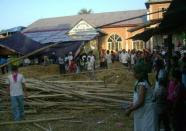 Ketsana typhoon has hit the Philippines and Vietnam, Wednesday, September 30, 2009 early morning hit Cambodia. At least nine people were killed in Kampong Thom Province, central Cambodia. When the hurricane region memorakporandakan Vietnam, Tuesday, more than 30 people were killed and nearly 200,000 others displaced from their homes. Flooding to this day still hit the middle region of Vietnam. In the Philippines, when the hurricane struck last weekend, at least 246 people were killed. The aid workers in the Philippines is still struggling to feed and accommodate the hundreds of thousands of people who lost their homes. Philippines parties claimed to have overwhelmed the disaster menghadi it. They also warned that a new storm was heading for the country.
Ketsana typhoon has hit the Philippines and Vietnam, Wednesday, September 30, 2009 early morning hit Cambodia. At least nine people were killed in Kampong Thom Province, central Cambodia. When the hurricane region memorakporandakan Vietnam, Tuesday, more than 30 people were killed and nearly 200,000 others displaced from their homes. Flooding to this day still hit the middle region of Vietnam. In the Philippines, when the hurricane struck last weekend, at least 246 people were killed. The aid workers in the Philippines is still struggling to feed and accommodate the hundreds of thousands of people who lost their homes. Philippines parties claimed to have overwhelmed the disaster menghadi it. They also warned that a new storm was heading for the country.In Vietnam, Ketsana come with heavy rains and wind speed kecang the lebi of 150 miles per hour before it finally leads to the northern Cambodia and southern Laos. At Vietnamese officials say, hurricanes usually weaken if it reaches the mainland but still dangerous Ketsana. "At least nine people were killed by debris last night when their house collapsed," said Chea Cheat, chairman of the Red Cross in Kampong Thom province, about 130 kilometers north of Phnom Penh, the Cambodian capital. He added, at least 78 homes were damaged in the province and heavy rains and floods continue to occur.
Labels: Blogging , Natural Disasters



















